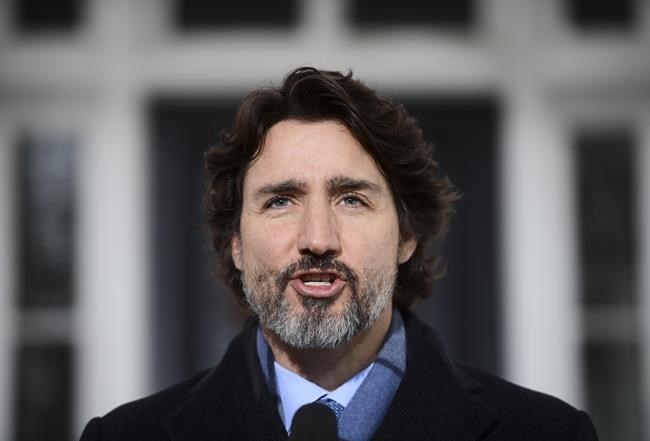OTTAWA — Canada's biggest province declared a new state of emergency Tuesday and is invoking a stay-at-home order as COVID-19 threatens to overwhelm Ontario hospitals.
The dire news came as Prime Minister Justin Trudeau announced Canada has secured another 20 million doses of the Pfizer-BioNTech vaccine for the virus that causes COVID-19. Along with doses of Moderna's vaccine, this means Canada has enough confirmed shipments to vaccinate every Canadian who wants it by the fall.
The shipping schedule currently has three million Canadians on track to be vaccinated by the end of March, another 10 million by the end of June and a further 22 million by the end of September.
Ontario Premier Doug Ford said the vaccines provide hope that wasn't there when his province implemented a state of emergency the first time last March. However, he said vaccines will not stop the pandemic until a critical mass of people are vaccinated.
New modelling in Ontario released Tuesday projected soaring cases and deaths if more isn't done to slow the spread of the virus.
Hospitals in many regions are already overwhelmed with half the province's intensive-care units at capacity or with just one or two open beds at any given time. More than 1,700 people are being treated in Ontario hospitals for COVID-19, including 385 in intensive care and 262 on ventilators.
"The system is on the brink of collapse," Ford said.
Ontario reported 2,903 new cases of COVID-19 Tuesday, which was the first time in more than a week daily cases fell below 3,000. But another 41 people had died in the province since Monday and 138 more were admitted to hospital because of COVID-19.
Ontario is not alone. Quebec warned Monday that its hospitals are so stretched doctors might soon be forced to decide who gets a ventilator and who doesn't. Quebec hospitals have 1,497 COVID-19 patients, including 221 in intensive care.
Quebec implemented an 8 p.m. to 5 a.m. curfew last weekend, but Ontario is opting for a stay-at-home order rather than a curfew.
Ford said the state of emergency will allow police, bylaw officers and workplace safety officers to ticket people who leave their homes for non-essential reasons. Acceptable reasons include buying groceries, going to a pharmacy, physical exercise, and going to and from an essential job.
The order also restricts hours for non-essential retailers offering curbside pickup, and limits outdoor gatherings to a maximum of five people, instead of 10.
Saskatchewan, which reported 248 new cases Tuesday, extended its public health orders until Jan. 29, including occupancy restrictions on restaurants, movie theatres, places of worship and fitness classes.
Alberta announced a new record daily high of 38 deaths due to COVID-19, along with 652 new cases.
Manitoba was a limited bright spot on the day, reporting fewer than 100 new cases for the first time since October.
Manitoba also began vaccinating long-term care residents Monday, as vaccines continue to roll out across the country, albeit much more slowly than most people would like.
As of 4 a.m. Tuesday, almost 360,000 doses of vaccines had been administered in Canada, about two-thirds of the quantity that have been shipped to Canada to date. Another 208,650 doses of Pfizer's vaccine and 171,700 of Moderna's are expected in Canada this week.
Provincial governments are still clamouring to get more doses faster, and Procurement Minister Anita Anand said Canada increased its spring allocation from Pfizer by two million doses. But there is no change to the six million doses scheduled to arrive this winter.
Health Canada is reviewing two other vaccines but can't make a decision about either AstraZeneca's or Johnson & Johnson's candidates until they report on their U.S. trials. Data from both is expected in late January or early February.
Together, those two vaccines could vaccinate about 20 million Canadians, but there is no information yet on when they could be approved or when the first doses would begin to arrive.
Canada has options to buy even more from both Pfizer and Moderna but those deliveries wouldn't come until late this year or even into 2022.
Front-line health workers and long-term care residents are the first priorities for vaccines, and Canada's chief public health officer Dr. Theresa Tam said Tuesday we should start to see the impact of those groups being vaccinated within a month or two.
Tam said we don't know yet if the vaccines prevent the virus from being transmitted at all, but they do prevent serious illness and long-term care residents are particularly vulnerable.
Forty per cent of Ontario's long-term care homes are experiencing outbreaks right now and one in 10 of the new cases reported in the province Tuesday occurred in long-term care. Across Canada, more than 44,000 long-term care residents and 19,500 staff have contracted COVID-19.
More than 70 per cent of the Canadians who have died from COVID-19 to date were residents in long-term care homes.
Ontario Health Minister Christine Elliott said the province has also detected eight more cases of a COVID-19 variant from United Kingdom, bringing the total number detected across Canada now to at least 22.
Provincial officials are worried the new variant is already spreading rapidly. Five of the eight new cases are linked to one person who recently travelled from the U.K.
The variant is believed to spread more easily but does not cause more severe illness. Preliminary studies from Pfizer show its vaccine protects against the new variant as well.
Trudeau also announced Tuesday that the Canada-U.S. land border will remain closed to non-essential travel until at least Feb. 21 — another 30-day extension to the restrictions in place since mid-March.
This report by The Canadian Press was first published Jan. 12, 2021.
Mia Rabson, The Canadian Press



